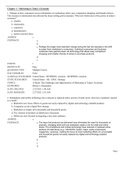Examen
Test Bank for Marketing Strategy, 8th Edition by O. C. Ferrell
- Cours
- Établissement
Test Bank for Marketing Strategy: Text and Cases 8e 8th Edition by O. C. Ferrell, Michael Hartline; Bryan W. Hochstein. ISBN-13: 6300 Full Chapters test bank included Chapter 1: Marketing in Today’s Economy 1.1: Introduction 1.2: The Challenges and Opportunities of Marketing in Today�...
[Montrer plus]



